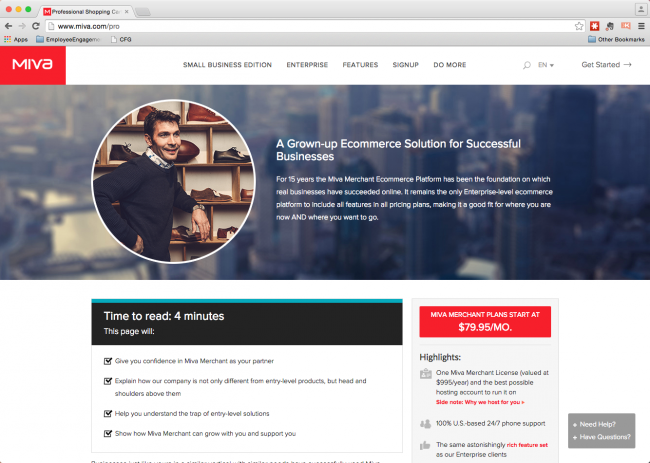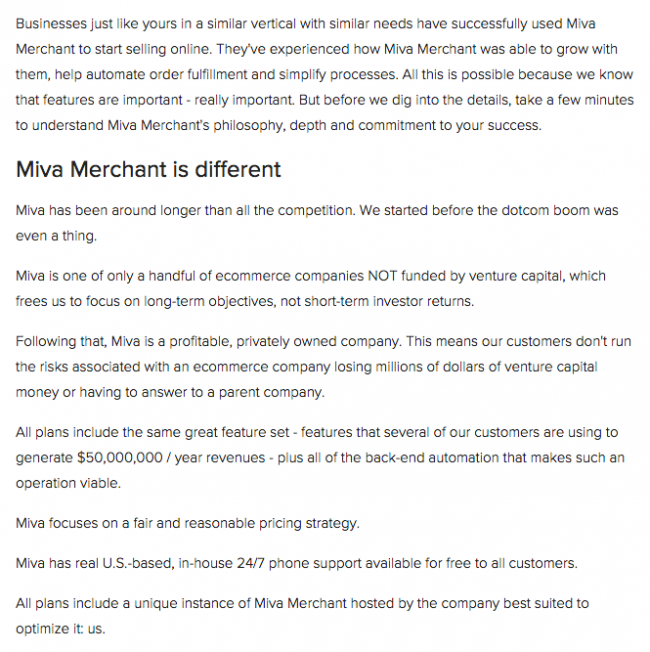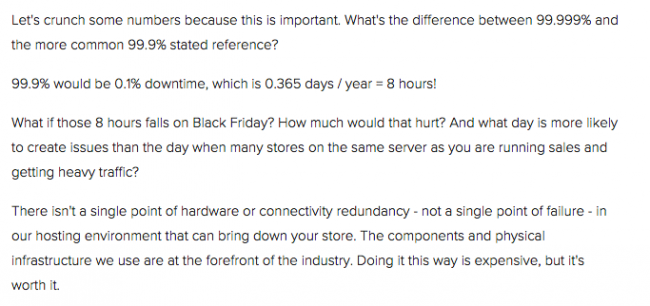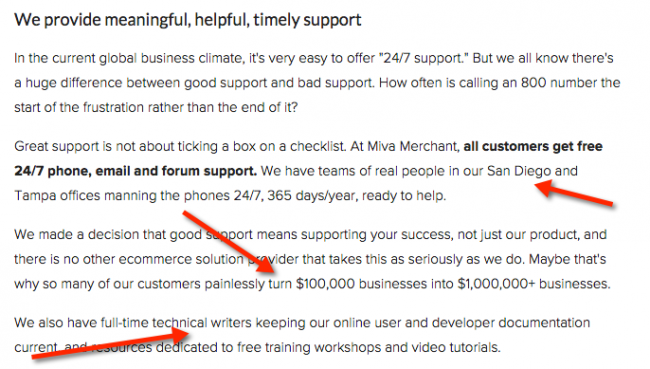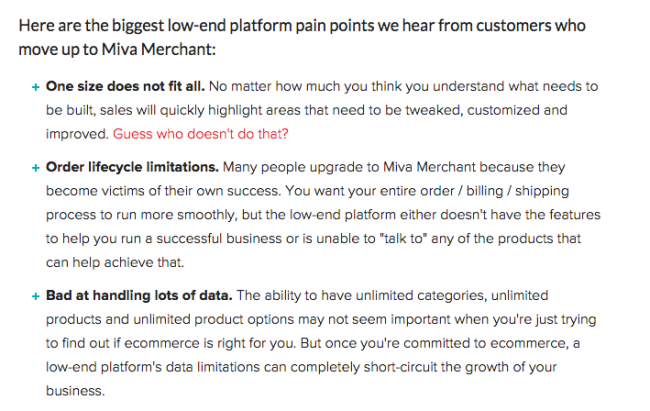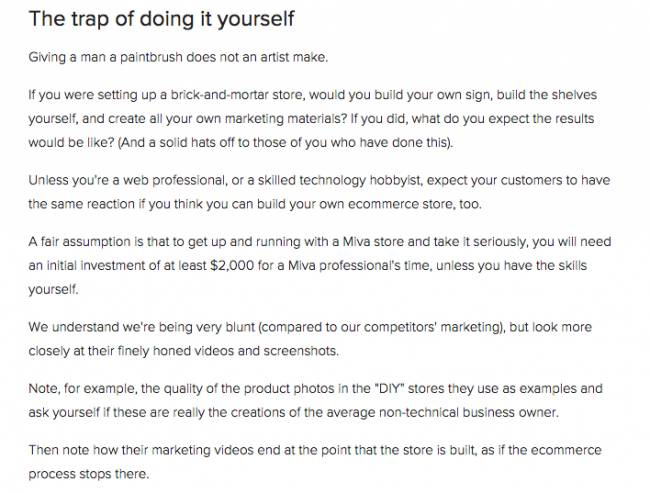What if there was a template to follow for marketing your software product? It would be nice, wouldn't it?
Unfortunately, the people who are great at it don't tell you their secrets and the people who tell you their secrets aren't great at it. But every now and then I come across a jewel and I have to pick it apart and use it as a case study.
Today I want to share with you some insights from the Small Business section of Miva – a hosted eCommerce solution, whose site I was recently browsing.
What I found was that my five rules were demonstrated perfectly—giving me maybe the best case study ever for product marketing copywriting.
Let's dig in.
Rule One: Always manage expectations
One of my favorite features of this page is their focus on managing my expectations, even when it comes to reading. Everyone who creates products knows that expectations management is key. But that shouldn't start when negotiating the purchase. It starts at the very first touchpoint—which Miva has done.
Another angle on the expectations management component is pricing. Notice that the price is clear above the fold. It's right there, without making you fill out forms or scroll around. But it's not the “main” message because pricing rarely is.
Rule Two: Tell your story well
When companies start writing about their products, they normally jump into features. This is a bit like talking about our future kids' names on a first date. Slow down!
More importantly, when prospects are first checking you out, they want to know that you understand them, that you've taken care of others just like them. And that means learning how to tell your story.
Notice that Miva explains their story without talking a lot about history. They're not telling you about their founder, their first office, and all that. They're telling you something more important than that.
If you get nothing else from this article, I hope you learn to tell your story as effectively as Miva.
Who you are today is a function of where you've come from. The way you operate is a logical conclusion of the decisions you've made, based on the values you have.
Rule Three: Use contrast to differentiate
I hope, as you read this page, you're starting to appreciate the genius behind this copy and how well they're doing their job. It's rare, seriously rare, to find as well put together a page as this—when it comes to marketing to small businesses.
One of the tricks I share with people who are public speakers is that contrast rules. It's what helps ideas stick in people's brains. We all love and embrace contrast.
So it's no surprise that Miva uses it to their advantage.
Look at what they're doing—they're mitigating risk and fear by bringing it up and then knocking it down. But as they talk about SaaS failures based on software updates, they're also creating some natural contrast.
On the one hand, you have all the SaaS companies and solutions that experience failure when software patches get rolled out. On the other hand, you have them.
On the one hand you have eCommerce solutions that put limits on you. On the other, you have them.
They hit it again, with regards to hosting and uptime.
Again, you have companies that have 8 hours of downtime a year, and then you have them.
There are few things as important, as you introduce your product offering, as learning how to differentiate yourself from your competition. If you do it right, you're leaving landmines behind you for your competitors.
Rule Four: Humanize your offering
One of the biggest problems I see when companies market their technology solutions is that they focus so much on what they perceive to be the biggest challenge they've overcome—the technology. So they write their marketing company to sound like they've solved the toughest technical challenges.
But you're selling to humans. And as long as you're selling to humans, you'll be well advised to humanize your offering.
Check out how Miva does it.
They tell you where their offices are, with real people in them. They talk about their customer's success in a way that makes it sound like they really care. They have even hired people to help clients with their own business because they understand that their success is dependent on their client's success.
Rule Five: Leverage loss aversion
What anyone who has studied psychology will tell you is that loss aversion is a real thing. People are more willing to lose a potential upside than to suffer a real loss.
Have I told you this already?
Two well known researchers—Kahneman and Tversky—performed a series of studies together, where they asked people to bet on a coin flip. The real challenge here wasn't the coin toss. It was the determination of how much they'd have to pay people to participate in the study. The average payoff on a coin toss that might result in a loss of $20 was $40.
Think about that.
People had to be paid twice as much to mitigate the potential loss of $20. We all hate losing things. We even hate it more than we like winning.
Notice how Miva uses loss aversion in their final section of their copywriting.
What they're saying, essentially, is “don't make the same mistakes others have made, which has resulting in some things you likely don't want.”
And it's brilliant. They continue—with the “trap of doing it yourself.”
Marketing your software product isn't easy
I have product marketing conversations all the time. I share these rules a lot. But rarely do I have a perfect example to point to.
Product marketing isn't easy. Writing copy isn't easy. It's why I regularly send people to copyhackers.
From here on out, I'm happy to point people there, but also to this article or to Miva, as they clearly understand how to market their product in an unquestionably congested yet growing space.
And if you decide you don't want to do your online eCommerce with WordPress and WooCommerce, you may want to check out Miva for yourself.

